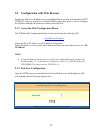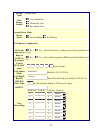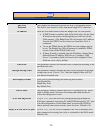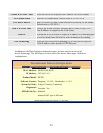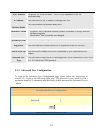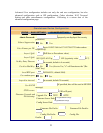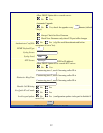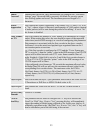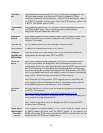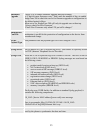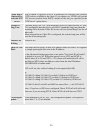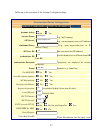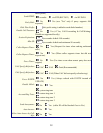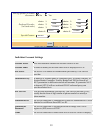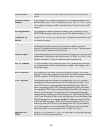
33
Admin
Password
Administrator password. Only administrator can configure the “Advanced
Settings” page. Password field is purposely left blank for security reason
after clicking update and saved. The maximum password length is 25
characters.
Silence
Suppression
This controls the silence suppression/VAD feature of G723 and G729. If set
to “Yes”, when a silence is detected, small quantity of VAD packets (instead
of audio packets) will be sent during the period of no talking. If set to “No”,
this feature is disabled.
Voice Frames
per TX
This field contains the number of voice frames to be transmitted in a single
packet. When setting this value, the user should be aware of the requested
packet time (used in SDP message) as a result of configuring this parameter.
This parameter is associated with the first vocoder in the above vocoder
Preference List or the actual used payload type negotiated between the 2
conversation parties at run time.
e.g., if the first vocoder is configured as G723 and the “Voice Frames per
TX” is set to be 2, then the “ptime” value in the SDP message of an INVITE
request will be 60ms because each G723 voice frame contains 30ms of
audio. Similarly, if this field is set to be 2 and if the first vocoder chosen is
G729 or G711 or G726, then the “ptime” value in the SDP message of an
INVITE request will be 20ms.
If the configured voice frames per TX exceeds the maximum allowed value,
the BudgeTone 200 will use and save the maximum allowed value for the
corresponding first vocoder choice. The maximum value for PCM is
10(x10ms) frames; for G726, it is 20 (x10ms) frames; for G723, it is 32
(x30ms) frames; for G729/G728, 64 (x10ms) and 64 (x2.5ms) frames
respectively.
Layer 3 QoS
This field defines the layer 3 QoS parameter which can be the value used for
IP Precedence or Diff-Serv or MPLS. Default value is 48.
Layer 2 QoS
This contains the value used for layer 2 VLAN tag. Default setting is
blank.
No Key Entry
Timeout
Default is 4 seconds.
Use # as
Send Key
This parameter allows users to configure the “#” key to be used as the
“Send” (or “Dial”) key. If set to “Yes”, pressing this key will immediately
trigger the sending of dialed string collected so far. In this case, this key is
essentially equivalent to the “(Re)Dial” key. If set to “No”, this “#” key will
then be included as part of the dial string to be sent out.



